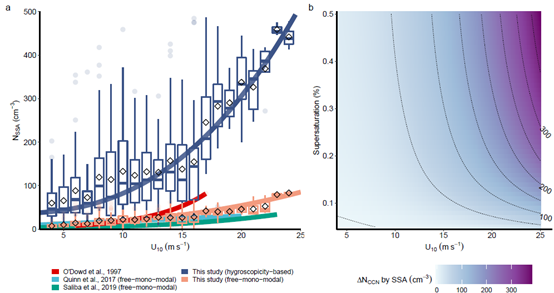Sea spray aerosols (SSAs), produced via bubble burst on the interface of atmosphere and ocean, are important component in the earth climate system and constitutes a major source of uncertainty in predicting the future climate. The SSA source function is a fundamental input parameter in many global atmospheric transport models. It has been suggested that the sea spray aerosol (SSA) contribute small fraction to cloud condensation nuclei (CCN) in global ocean, due to the low number concentration of SSA. However, the SSA number concentration was poorly constrained and often extrapolated from supermicron size distribution.
Recently, a joint research published in Nature Geoscience led by Prof. HUANG Ru-Jin from the Chinese Academy of Sciences and Dr. Darius Ceburnis and Prof. Colin O’Dowd from NUI Galway (Ireland) found that the contribution of SSA to CCN was largely overlooked on a global scale.
Deriving SSA number size distribution
In the new study, the international research team proposed a new method of deriving SSA number size distribution by using the ultra-high hygroscopicity signature of the sea salt, the major component of SSA over North Atlantic during winter time. Based on over 5-years semi-continuous on-line measurement, The SSA number size distribution versus meteorological conditions were parameterised. The newly proposed SSA size-resolved source function used four unconstrained log-normal modes fitting. The relationship between SSA number and wind speed varied for different SSA modes, indicating different bubble-mediated production mechanisms.
Implications for aerosol-cloud interaction
Based on the hygroscopicity measurement, a large contribution of Aitken mode SSA number has been found, pointing to their potential role in acting as marine CCN. Conventional way to describe SSA number size distribution utilized a very broad lognormal distribution by extrapolating the number size distribution of large particles (larger than 0.5 μm). The mode diameter was constrained to the sea spray laboratory experiments, and the broad distribution aimed to encapsulate multiple unspecified sea spray production mechanisms. By comparing the two methods, it is found that SSA number was underestimated by up to 5-folds, depending on the wind speed. This is the first study that elucidates the sub-micron SSA size distribution and its source functions, revealing the substantial underestimation of SSA number concentration, updating the traditional understanding that SSA was not important to marine CCN, and providing reliable parameterisation for air-sea exchange and climate prediction.

IMAGE: a) The SSA number concentration under different wind speed conditions by using different methods; b) the difference in SSA contribution to CCN under different wind speed and supersaturation. (Image by XU, et al)
Contact: Prof. Ru-Jin Huang, Institute of Earth Environment, Chinese Academy of Sciences, Xi'an, China. Email: rujin.huang@ieecas.cn
Dr. Darius Ceburnis or Prof. Colin O’Dowd, National University of Ireland, Galway. Email: darius.ceburnis@nuigalway.ie or colin.odowd@nuigalway.ie
 © 2015 Institute of Earth Environment,CAS
© 2015 Institute of Earth Environment,CAS Address:No. 97 Yanxiang Road, Xi'an 710061, Shaanxi, China

 Location :
Location :